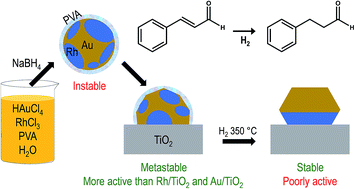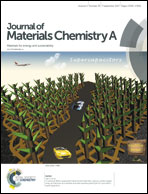Monitoring in situ the colloidal synthesis of AuRh/TiO2 selective-hydrogenation nanocatalysts
Abstract
AuRh nanoparticles (NPs) of various compositions and sizes in the 2–4 nm range were synthesized using a colloidal approach and were characterized at each preparation step by dynamic light scattering (DLS), ultraviolet-visible (UV-vis) spectroscopy, and liquid-phase transmission electron microscopy (liquid TEM). The AuRh colloids appear relatively instable, leading to their gradual coalescence. After fast immobilization of the metallic nanoparticles on rutile TiO2 nanorods, the materials were investigated by high-resolution transmission electron microscopy (HRTEM) and low-temperature CO adsorption monitored by Fourier transform infrared (FTIR) spectroscopy. The inherent lack of miscibility between Au and Rh leads to partial segregation inside the NPs, which is further exalted after a reducing thermal treatment applied for PVA removal. The catalytic properties in the liquid-phase selective hydrogenation of cinnamaldehyde to hydrocinnamaldehyde are strongly influenced by these nanostructural modifications. While in as-prepared samples the intermixing between Au and Rh phases promotes the catalytic performances for Rh-rich AuRh catalysts through Au-induced stabilization of Rh in its metallic form, segregation into Janus particles after reduction decreases the catalytic activity.



 Please wait while we load your content...
Please wait while we load your content...